Everything You Need to Know About Gas Range Safety Valves
Updated: 5 May 2024
679
Did you know that gas range accidents are among the most common household hazards? This unsettling fact highlights the critical need for proper safety mechanisms in our kitchens.
One such vital component is the gas range safety valve, a device engineered to prevent dangerous gas leaks and ensure the safe operation of your cooking appliances.
Gas range safety valves are designed to cut off the gas supply automatically if a flame is extinguished, preventing the potential for gas buildup and subsequent accidents. They are crucial for the safety of your home, acting as a guardian against gas-related incidents.
But despite their importance, many homeowners are unaware of how these valves work, the maintenance they require, or even the regulations governing their use.
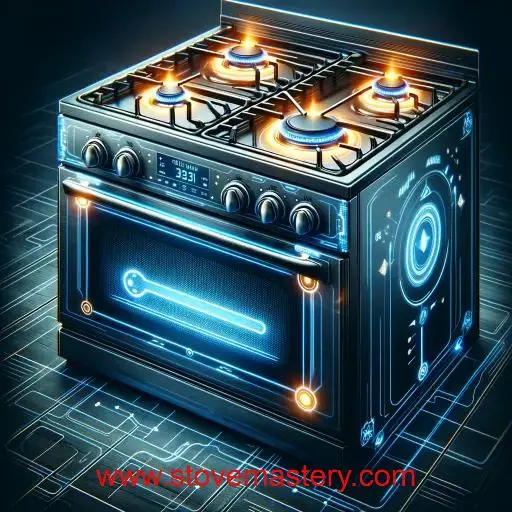
In this post, we’ll delve into everything you need to know about gas range safety valves—from their basic functionality and types to installation, maintenance, and compliance with safety regulations.
By understanding these components, you can ensure your kitchen is not only a place of culinary creativity but also a safe environment for your family.
Exploring The Kitchen Saviour: Gas Stove Safety Valve
Understanding Gas Range Safety Valves
Definition and Purpose
A gas range safety valve is a crucial component designed to enhance safety in gas-operated cooking appliances. Its primary purpose is to prevent gas leaks that could lead to dangerous situations, including explosions or fires. The valve automatically shuts off the gas supply if no flame is present, ensuring that gas does not continue to flow if it cannot be ignited, thus playing a pivotal role in kitchen safety.
Types of Safety Valves
Gas ranges typically utilize one of several types of safety valves, each with unique characteristics and mechanisms:
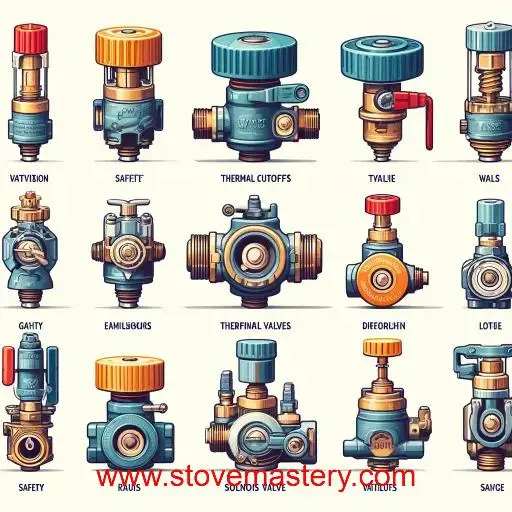
- Thermocouple Valves: These are the most common type of safety valve. They consist of a sensor that is directly exposed to the flame. If the flame goes out, the temperature drop is detected by the thermocouple, which then triggers the valve to close, cutting off the gas supply.
- Thermopile Valves: Similar to thermocouples but capable of generating more electricity to control larger valves or multiple functions at once. They are often used in commercial kitchens where higher gas volumes are common.
- Solenoid Valves: These are electrically controlled valves used in more modern or advanced cooking appliances. They require electrical power to operate and can be controlled by the appliance’s electronic control system to offer precise control over gas flow.
- Mercury Flame Sensors: While less common today due to environmental concerns, these sensors use mercury switches that open or close the gas valve based on the presence of a flame.
Advantages and Limitations
Each type of valve has its advantages. For instance, thermocouple valves are highly reliable and simple, making them suitable for most residential gas ranges. Thermopile valves, on the other hand, provide additional power and functionality, suitable for professional-grade appliances.
However, there are also limitations. Solenoid valves depend on electrical power, which means they can fail during a power outage, potentially causing safety issues. Meanwhile, mercury flame sensors pose environmental risks and are being phased out in many regions.
Understanding these different types of safety valves and their operational nuances is crucial for choosing the right safety features for your specific needs, ensuring both functionality and safety in your kitchen’s gas range.
How Gas Range Safety Valves Work
Operation Mechanism
Understanding the operation of gas range safety valves is crucial for recognizing their importance in kitchen safety. These valves ensure that gas flows to the burner only when there is a safe flame present to ignite it. The key mechanism involves a control system that senses the flame and regulates the gas flow accordingly.
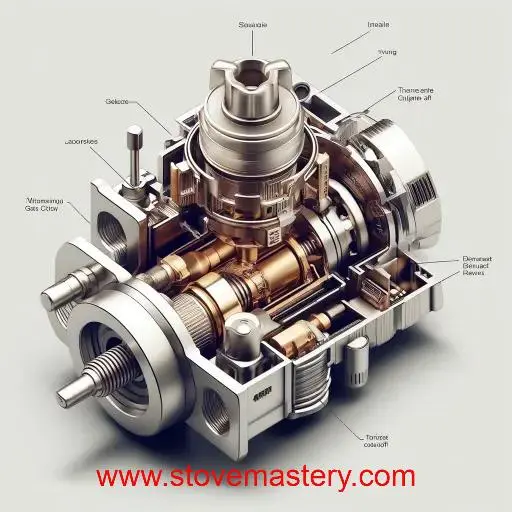
Here’s a breakdown of how these safety mechanisms typically work:
- Flame Detection: When the gas range is turned on, the safety valve relies on a sensor to detect the flame. For thermocouple and thermopile systems, this is achieved through direct heat contact which generates a small electric current sufficient to keep the valve open.
- Valve Operation: If the sensor fails to detect a flame, such as when the flame extinguishes unexpectedly, it stops generating the current. This lack of current causes the safety valve to close automatically, cutting off the gas supply to prevent leaks.
- Control System: In systems with solenoid valves, an electronic control system can also intervene. It monitors the burner’s status and can shut off the gas supply electronically, which is particularly useful in complex appliances with multiple functions or safety concerns.
Key Components
The effectiveness of a gas range safety valve hinges on several critical components:
- Sensor (Thermocouple or Thermopile): Sensitive to heat and responsible for generating the electric current needed to keep the valve open.
- Valve Body: The physical barrier that opens or closes to allow or block the flow of gas.
- Control System (especially in solenoid valves): Provides electronic oversight of the flame and gas flow, enhancing the appliance’s safety and operational efficiency.
These components must work in harmony to ensure the safety and efficiency of your gas range. Regular checks and maintenance are required to keep them functioning properly, as even minor faults can compromise the system’s integrity.
Visual Aids
To help further understand these mechanisms, diagrams or infographics can be beneficial. These visuals can depict the flow of gas, the electrical connections between the sensor and the valve, and how the components interact when the gas range is in use. This not only aids in understanding but also in troubleshooting and maintaining the system effectively.
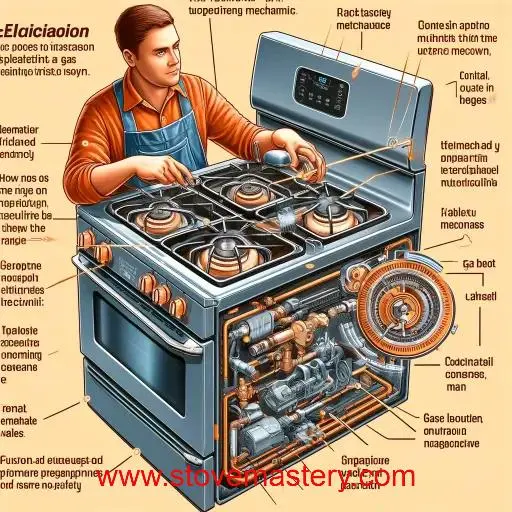
By comprehending how gas range safety valves operate, homeowners can better appreciate the sophisticated safety measures built into their kitchen appliances, ensuring safer cooking environments.
Installation and Maintenance
Installation
Proper installation of a gas range safety valve is crucial for ensuring the appliance operates safely and efficiently. Here’s a step-by-step guide to ensure correct installation:
- Choose the Right Valve: It’s vital to select a safety valve that matches the specifications of your gas range. Compatibility ensures efficient operation and avoids potential safety risks.
- Secure Connections: During installation, all connections must be securely fastened. Loose connections can lead to gas leaks, which are a significant hazard. Using appropriate tools and following the manufacturer’s guidelines can prevent such issues.
- Test the System: After installation, it is imperative to test the system thoroughly. This includes checking for leaks using a soap solution along the connections and observing the valve operation to ensure it opens and closes correctly under normal operating conditions.
Pro Tip: Always consult a certified and knowledgeable professional installer about gas appliances to ensure that the installation meets all safety standards and local regulations.
Maintenance
Maintaining your gas range safety valve is essential to ensure its longevity and safe operation. Here are some key maintenance tasks:
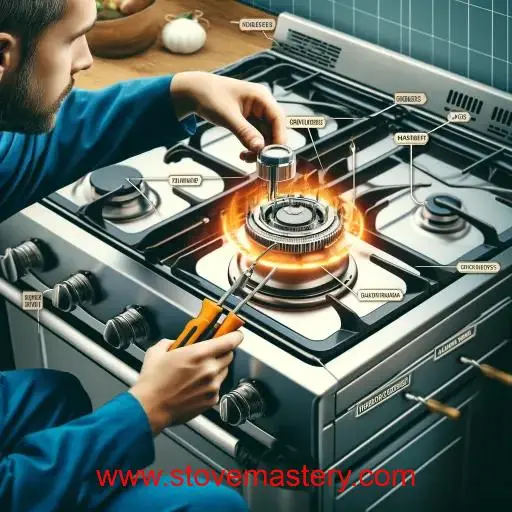
- Regular Cleaning: Keep the area around the valve clean and free from grease build-up. Grease can interfere with the operation of the valve and pose a fire risk.
- Annual Inspections: Have a professional inspect the safety valve annually. They will check for signs of wear and tear, ensure the valve is operating correctly, and make any necessary adjustments or replacements.
- Immediate Repairs: If you notice any issues during regular use, such as the valve failing to shut off gas or a weak flame, address these immediately. Delaying repairs can compromise the safety of your appliance.
DIY Maintenance Tips
For those comfortable with basic home maintenance, here are a few DIY tips:
- Visual Checks: Regularly inspect your safety valve for signs of wear or damage. Look for any visible signs of corrosion or leakage.
- Test the Valve: You can test the valve by turning off the stove and watching to see if the valve correctly stops the gas flow.
- Clean Regularly: Use a non-abrasive cleaner to remove dirt and grease buildup from the valve area without damaging any components.
When to Seek Professional Help
While DIY maintenance can be sufficient for minor issues, certain situations require professional expertise:
- Installation: Always have a new gas safety valve installed by a professional.
- Major Repairs: If the valve is damaged or fails repeatedly, professional repair or replacement is necessary.
- Regulatory Compliance: Ensure that any major work done on your gas systems complies with local safety regulations, often necessitating professional involvement.
Additional Resource Link: For those looking to understand more about the technical aspects or need a professional service, consider visiting Find a Certified Gas Safety Technician.
Regular upkeep and correct installation of your gas range safety valve are not just about maintaining operational efficiency but are crucial for safeguarding your household. Taking these steps will help prevent potential hazards and extend the lifespan of your gas range.
Legal and Safety Regulations
Navigating the legal and safety regulations surrounding gas range safety valves is essential for any homeowner. Compliance not only ensures safety but also adheres to legal standards that can prevent costly fines and liabilities.
Regulatory Compliance
Gas ranges must meet specific safety standards, which vary by country and region. These standards are designed to ensure that every safety valve operates effectively in preventing gas leaks and accidents. Homeowners are responsible for ensuring their appliances comply with these standards. Non-compliance can lead to serious legal repercussions, including fines and potential criminal charges in the case of accidents.
For example, in the United States, the National Fire Protection Association (NFPA) sets guidelines for the installation and maintenance of gas appliances, including stoves. These guidelines are part of broader building codes and safety regulations that may also be enforced by local governments or safety agencies.
Importance of Compliance
It’s crucial to understand the regulations in your area. Compliance isn’t just about avoiding penalties—it’s about ensuring your family’s safety. Properly installed and maintained safety valves significantly reduce the risk of gas leaks and the resultant hazards they pose.
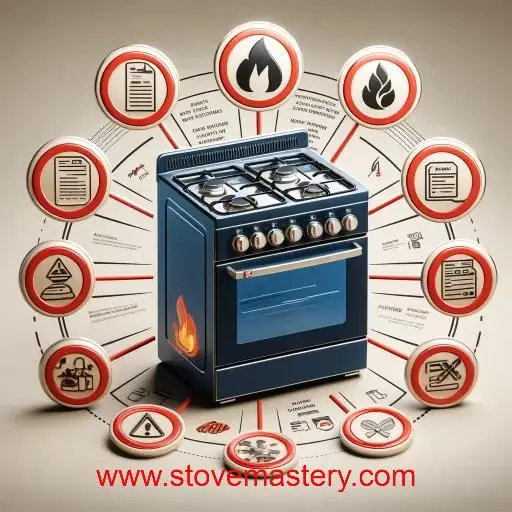
“Prevention is the best protection,” aptly summarizes the ethos behind these regulations. By adhering to established safety standards, you can safeguard your home against potential disasters, ensuring a safe environment for cooking and living.
How to Ensure Compliance
- Consult Professionals: When installing a new gas range or replacing parts like safety valves, it’s advisable to consult with certified professionals who are familiar with local safety regulations.
- Regular Inspections: Schedule regular inspections with authorities or certified technicians who can verify that your installation meets all local and national safety standards.
- Stay Informed: Keep abreast of changes in safety regulations by checking updates from your local building department or safety regulation websites.
By understanding and complying with these legal and safety regulations, you not only protect your home and loved ones but also contribute to a culture of safety in your community. Ensuring your gas range meets these standards is an investment in peace of mind and the well-being of all who use your kitchen.
Common Issues and Troubleshooting
Even with the best installation and regular maintenance, common issues with gas range safety valves can arise. Recognizing these problems and knowing how to address them quickly can prevent hazards and keep your stove in optimal working condition.
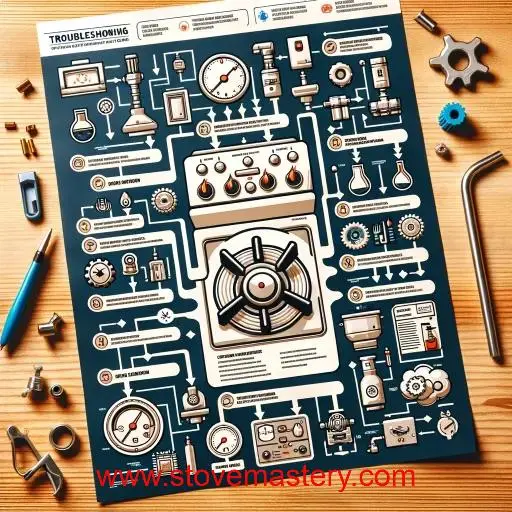
Typical Issues
Here are some of the typical issues you might encounter with gas range safety valves:
- Valve Sticking: Sometimes, the valve may not close completely, or it may stick in the open position. This usually happens due to residue buildup or mechanical wear.
- Sensor Failure: The sensor, crucial for detecting the flame, might fail or become less responsive, often due to dirt, grease, or damage. This failure can prevent the valve from operating correctly, leading to potential gas leaks.
- Mechanical Wear: Over time, components of the valve, especially moving parts like springs and seals, can wear out. This wear can affect the valve’s ability to open and close properly, necessitating repairs or replacements.
Troubleshooting Steps
If you encounter issues with your gas range safety valve, here are some steps you can take:
- Clean the Valve: Often, cleaning the valve and the area around it can resolve sticking issues. Remove any buildup of grease or debris that might be interfering with the valve’s operation.
- Check the Sensor: Inspect the sensor to ensure it is not covered or physically damaged. A clean and intact sensor is crucial for accurate operation.
- Inspect for Wear: Look for visible signs of wear or damage on the valve components. Replace worn parts as needed to maintain optimal function.
When to Call a Professional
While some troubleshooting can be done at home, certain situations should be handled by professionals:
- Complex Repairs: If the safety valve or its components need complex repairs or complete replacement, it’s safer and more efficient to hire a professional.
- Persistent Issues: If issues recur or you notice unusual behavior in the gas range’s operation, professional diagnosis and repair are advisable.
- Safety Concerns: Anytime you are unsure about the safety of your appliance, such as when you smell gas or suspect a leak, it’s critical to call a professional immediately.
Maintenance Tips
To prevent common issues:
- Regular Maintenance: Adhere to a regular maintenance schedule, including professional inspections.
- Immediate Action: Address any signs of malfunction immediately, even if they seem minor. Small issues can escalate into major hazards.
By understanding these common issues and how to troubleshoot them, you can ensure your gas range continues to operate safely and efficiently. Regular maintenance and awareness of potential problems are key to preventing gas-related incidents in your home.
Enhancing Safety with Advanced Features
The evolution of technology has introduced advanced features that enhance the safety and functionality of gas range safety valves. These innovations not only improve the reliability of gas appliances but also offer greater peace of mind through enhanced protective measures.
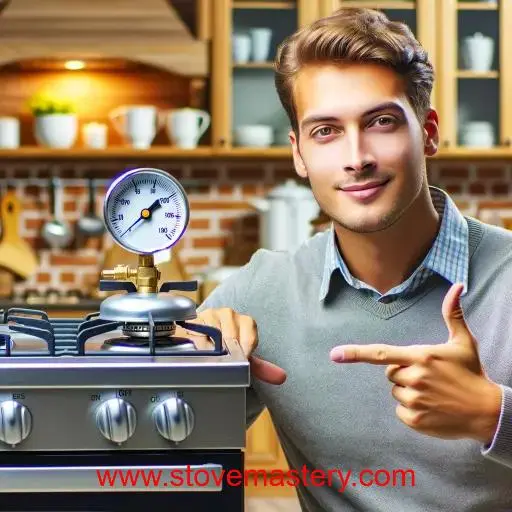
Advanced Safety Features
- Automatic Re-ignition: This feature automatically relights the burner if the flame goes out unexpectedly. It ensures continuous operation without the risk of gas leakage, providing an added layer of safety.
- Child Safety Locks: Many modern gas ranges include child safety locks that prevent unauthorized use, particularly important in households with young children. This feature can disable the gas supply or prevent the controls from being operated.
- Timer Shutoff: A timer shutoff mechanism is designed to turn off the gas after a specified period automatically. This is particularly useful for preventing accidents that could arise from unattended stoves, ensuring the appliance is safe when not in active use.
- Gas Leak Detectors: Integrated into some gas ranges, these detectors can sense when an unusual amount of gas is present and automatically shut off the supply, alerting the user to the potential danger.
Benefits of Advanced Safety Technologies
- Increased Safety: Each of these features adds a layer of safety that helps to prevent accidents before they happen.
- Convenience and Peace of Mind: The convenience of advanced safety features allows users to cook with less worry and more confidence, knowing that their appliance has robust safety mechanisms in place.
- Energy Efficiency: Features like automatic shutoff not only enhance safety but also conserve energy by ensuring the appliance operates only when necessary.
Implementing Advanced Features
Implementing these advanced features can vary based on the model and make of the gas range. Here are some guidelines:
- Consult the Manufacturer: When purchasing a new gas range, consult the manufacturer’s guidelines to understand what safety features are included and how they function.
- Professional Installation: Ensure that advanced features are activated and properly configured by a professional during installation.
- Regular Updates and Checks: For ranges that include software-based controls or sensors, ensure that they are regularly updated and checked for proper functionality.
Conclusion
Advanced safety features in gas range safety valves represent a significant step forward in kitchen safety. By choosing appliances equipped with these features, homeowners can effectively mitigate risks associated with gas cooking, enhancing safety while enjoying the benefits of modern culinary technology. Regular maintenance and adherence to manufacturer guidelines will maximize the effectiveness of these safety enhancements, contributing to a safer, more efficient kitchen environment.
Please Write Your Comments